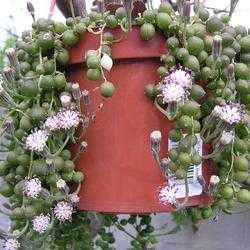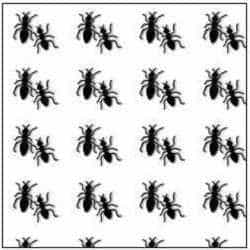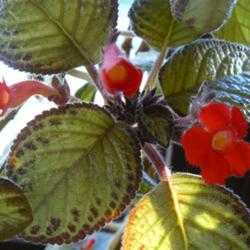As much as I would love to write this article using the usual suggestions of light, water, and warmth, I can't in all honesty do it. The Hoya is a mysterious creature. Being related to the milkweeds, you'd think they would be an easy plant to grow. Think again!!
The windowsill Wax plant (Hoya carnosa) that our grandmothers grew is the one you're all probably familiar with. In my opinion, it is the easiest of them all to grow. Surviving nicely to the side of a north-facing window and watered only when I remember, it thrives. Its blooms (pictured right) have the most intoxicating fragrance imaginable. I was happy with him. Then I discovered the Hoya forum here at Dave's Garden. Then everything got way out of control.
I got my first Hoya 15 years ago. It was given to me by a lady I worked for; she was tired of it refusing to bloom. I brought it home, ignored it for a few years and then one day it bloomed. WOW is all I can say. The entire house was permeated with this amazingly sweet scent in the evenings. Life was good. I was happy in my ignorance, believing that nothing could be better than my good old H. carnosa.
In the fall of 2005, about 2 days after I got my very first computer, I discovered Dave's Garden. I was randomly looking up all of my house plants, amazed at this new to me technology. Delighted at the idea of having the worlds library right at my fingertips. It was inevitable, I typed in "Hoya" and hit search.
 |
 |
 |
| PanamonCreel H. publicalyx | AlohaHoya H. cv. monette | PanamonCreel H. multiflora |
Right away I knew I was in trouble. I saw flowers of every colour and size imaginable. They ranged in size from very tiny to over two inches across!! Hoya flowers develop from an umbel grown on a peduncle. They will bloom from the same peduncle forever so it is wise to never dead-head your hoya. When I placed my first Hoya order I concentrated on the flowers. I ordered every size and colour imaginable. Then I learned my first Hoya lesson. Some Hoya are really hard to bring to flower! Yes, it's true. They can be very easy, or very fussy.
 |
 |
 |
| AlohaHoya H. magnifica | PanamonCreel H. publicalyx RHP | AlohaHoya H. sp. Apple Green, an Eriostemma |
The Hoya is native to Asia, Australia and Polynesia. They can be found growing in trees in a tropical rainforest or growing on a dry beach in almost desert-like conditions. This is where the challenge lies. Trying to find out what your specific Hoya needs to be happy. Some like to be warm and moist while others prefer to be cool and dry, and some prefer anything in between.
 |
 |
 |
| AlohaHoya H. macgillivrayi | ceedub H. lobbii | AlohaHoya H. affinis |
Hoya growing conditions can be as unique as the plants themselves are. After learning the lesson of the Hoya flower I was much wiser on my second large order. I decided to go for the beauty of the leaves. Yes, their leaves are indeed as unique and beautiful as are the flowers. From tiny and round to large, heavily veined monsters. Variegated, thin and strap-like, or velvety.They can even be curly.
 |
 |
 |
| AlohaHoya H. latifolia | AlohaHoya H. calystophylla | PanamonCreel H. nova |
This is where I learned my second Hoya lesson. You see, when ordered from afar, they come as un-rooted cuttings. The methods used to prod the cuttings into forming roots are also varied. Some people root their cuttings in straight perlite. Others use Hydroton, little clay marble-like pellets used in semi-hydroponics. I've seen them rooted in various combinations of the two. They can also root in a glass of water or in a sealed baggie with a mist of water sprayed in.
 |
 |
 |
| AlohaHoya H. erythrina | AlohaHoya H. wibergiae | PanamonCreel H. 'rainforest beauty' |
My third and so far last Hoya lesson has been soil. There are dozens of soil mix recipes out there. Various combinations of potting soil, perlite, Hydroton and orchid bark. The soil used can differ greatly depending on the plants origin (where it is found in the wild) and your location. Like I mentioned earlier, these guys can be fussy. There are a few varieties I can't grow to save my life. The challenge of it all is what keeps me trying.
 |
 |
 |
| PanamonCreel H. compacta | PanamonCreel H. cinnamomifolia | PanamonCreel H. ruthie |
Hoya can be slow growing or they can grow so fast the vines will almost wrap around you if you sit still too long. They are one of the most persnickety group of plants that I've known and yet their allure is so strong they turn ordinary folk into Hoya addicts in very short time.
As it stands now, I have 30 or so different Hoya with another 15 or so scheduled to arrive on my doorstep in the spring. Hubby thinks I'm out of control, but I know people who own over 100 different kinds. I've only just begun!!
My thanks to AlohaHoya, PanamonCreel and ceedub for the use of their magnificent Hoya photos.

















